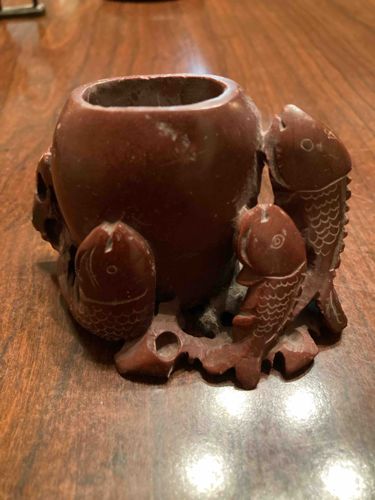
Carved Stone Fish and Pot/Vase Incense Holder
This item is a decorative carved stone object, likely functioning as an incense holder, brush pot, or small vase. It features a central cylindrical pot or cup-like vessel, from which several fish figures appear to emerge or support it. The material appears to be a reddish-brown stone, possibly soapstone or a similar soft carvable stone, given its texture and visible carving marks. The color is somewhat mottled, showing lighter reddish-brown tones where the stone might be more exposed or weathered, and darker, richer brown hues in recessed areas. The central pot has an observable rim, which appears somewhat uneven, indicating hand-carving. The interior is hollowed out, suggesting its utilitarian purpose. Surrounding the pot are at least four distinct fish figures, each individually carved with details such as eyes, gills, and scales. The scales are particularly intricate, created by a series of overlapping crescent shapes. Some fish point upwards, others horizontally, creating a dynamic composition. There is a base or stand integrated into the carving, shaped with organic, undulating forms that suggest water or rock formations, from which the fish and pot arise. One section of the base clearly shows two circular holes, which could be for holding incense sticks or other small implements. The overall condition shows signs of age and use, including some white residue or discoloration on the surface in various spots, particularly on the central pot and some of the fish. There are no obvious large chips or breaks visible, but the surface exhibits a rustic, somewhat worn patina consistent with a hand-carved stone object that has been handled over time. The craftsmanship is expressive, with a folk art quality. The style suggests an East Asian origin, likely from the mid-20th century or earlier, given the traditional motif of fish (often symbolizing abundance and prosperity) and the carving technique. The piece feels substantial and displays a distinct character indicative of artisanal creation rather than mass production.
AI-Generated Appraisal Disclaimer
Estimated Value
$150-250
Basic Information
Category
Decorative Arts
Appraised On
November 24, 2025
Estimated Value
$150-250
Additional Details Provided By Owner
User Provided Information
Carved stone incense holder?
Item Description
This item is a decorative carved stone object, likely functioning as an incense holder, brush pot, or small vase. It features a central cylindrical pot or cup-like vessel, from which several fish figures appear to emerge or support it. The material appears to be a reddish-brown stone, possibly soapstone or a similar soft carvable stone, given its texture and visible carving marks. The color is somewhat mottled, showing lighter reddish-brown tones where the stone might be more exposed or weathered, and darker, richer brown hues in recessed areas. The central pot has an observable rim, which appears somewhat uneven, indicating hand-carving. The interior is hollowed out, suggesting its utilitarian purpose. Surrounding the pot are at least four distinct fish figures, each individually carved with details such as eyes, gills, and scales. The scales are particularly intricate, created by a series of overlapping crescent shapes. Some fish point upwards, others horizontally, creating a dynamic composition. There is a base or stand integrated into the carving, shaped with organic, undulating forms that suggest water or rock formations, from which the fish and pot arise. One section of the base clearly shows two circular holes, which could be for holding incense sticks or other small implements. The overall condition shows signs of age and use, including some white residue or discoloration on the surface in various spots, particularly on the central pot and some of the fish. There are no obvious large chips or breaks visible, but the surface exhibits a rustic, somewhat worn patina consistent with a hand-carved stone object that has been handled over time. The craftsmanship is expressive, with a folk art quality. The style suggests an East Asian origin, likely from the mid-20th century or earlier, given the traditional motif of fish (often symbolizing abundance and prosperity) and the carving technique. The piece feels substantial and displays a distinct character indicative of artisanal creation rather than mass production.
Get Your Items Appraised
Instant estimates of your treasures with AI-powered instant appraisals